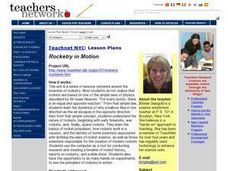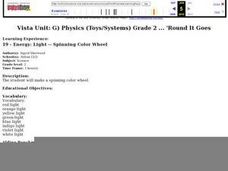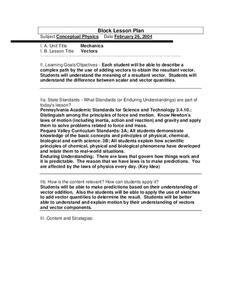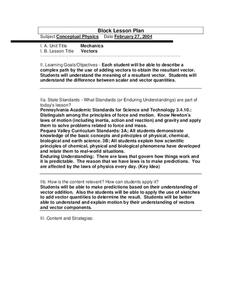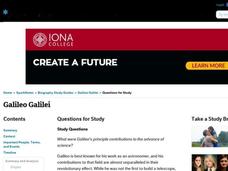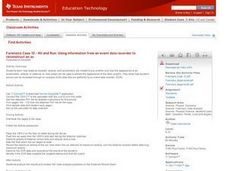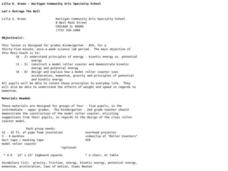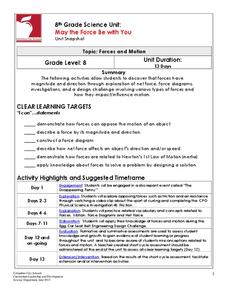Curated OER
Rocketry in Motion
Students investigate why a balloon flies in one direction as air escapes in the opposite direction, which helps them understand the nature of rockets and fireworks. Individually and in teams, students conduct research to create a...
Curated OER
The Seasons
Discover the change of the seasons by modeling the Earth-Sun system. Learners model the orbit of the Earth around the sun and explore how and why the patterns of winter and summer occur.
Curated OER
#22 Frames of Reference: The Basics
Students explore the concept of frames of reference in physics.
Curated OER
Frames of Reference: The Basics
Learners learn the concept of frames of reference in physics. They examine how two frames of reference, each moving with respect to the other with a constant velocity v (constant speed, constant direction).
Curated OER
"Girls Only" Science Workshop
Students design sleds. In this engineering lesson, students collaborate to engineer and build a real working sleds from the materials provided. This lesson was originally designed to be taught to a group of female students.
Curated OER
Energy: Light -- Spinning Color Wheel
Second graders make spinning color wheels to determine how energy effects what colors look like. They paint or color a color wheel with the seven colors of the spectrum. Next, the spin the wheel to determine what happens. In order to...
Curated OER
Antacid Tablet Race
Young scholars complete experiments to determine how rocket fuel is affected by surface area and temperature. They compare the reaction rates of antacid tablets. They discuss their results to complete the lesson.
Curated OER
Newtonian Mechanics
Students familiarize themselves, through teacher demonstration, with Gavendish's apparatus first used for experimentally determining the value of the Universal Gravitational Constant G, and calculate theoretical value of Earth's...
Curated OER
Catapults!
Students work together to discover the relationship between the angle of catapults and the flight of different objects. They discover the heavier the object the more force is needed. They examine how engineers use this information to...
Curated OER
What is ergonomics and why is it important?
Students come up with ideas to help friendly, superintelligent space aliens adapt to this environment.
Curated OER
Strawkets and Thrust
Students investigate the effect of thrust on rocket flight. They construct two paper rockets, one with a smaller exit nozzle, and compare/contrast the distances traveled by the rockets.
Curated OER
Vectors
Learners describe a complex path by the use of adding vectors. They comprehend the difference betwee scalar and vector quanitities. Students disucss the naviagation lab. They are explained the procedures for the lab. Learners are...
Curated OER
Vectors
Students describe a complex path by the use of adding vectors. They are explained the procedures and rules of the balloon car race. Students are remined that the summary and answers to the questions are due Monday. They are given the...
Curated OER
Galileo Galilei Questions for Study
For this online interactive philosophy worksheet, students respond to 10 short answer and essay questions about Galileo's contributions to science.
Curated OER
Sciences Working Together
Students research articles about science technology and society. In this science and technology lesson, students answer questions about an article they chose. They share what they learned with their peers.
Curated OER
Hit and Run
Pupils explore data collection in this lesson. They investigate distance vs. time and velocity vs. time graphs using information collected with a CBR 2 to simulate the reconstruction of an accident.
Curated OER
Let's Outrage the Bull
Students study kinetic and potential energy. In this energy instructional activity, students in grades K-2 understand the differences between kinetic and potential energy. Students in grades 3-5 demonstrate that kinetic and potential...
Curated OER
Circle of Pong
Students, in groups, use given materials to devise a way to deposit a ping-pong ball into a paper cup that is located in the middle of a 6-foot diameter circle, while standing outside the circle.
Columbus City Schools
May the Force Be with You
You won't have to force your classes to complete these engaging activities! Through exploration, young scientists learn that force has both magnitude and direction. They draw force diagrams, investigate force models, and complete a...
Curated OER
Olympic Training Center
Students decide on an activity like running, swimming or skating for a performance analysis. They have friends or family members videotape them as they exercise, then review the video to see how they can improve their performance.
Curated OER
Gravity, Forces, and Inertia
Learners participate in assessments involving gravity, forces, and inertia. They select from a menu of options assessments they would like to complete including worksheets, drawing posters, watching videos, creating crossword puzzles,...
Curated OER
Impact!!
Students perform a science experiment. In this algebra lesson, students collect data from their experiment and create a graph. They analyze the graph and draw conclusion.
Curated OER
Rube Goldberg Project
Young scholars apply inquiry and problem solving approaches in science. They design a device (invention) that solves a special problem.
Curated OER
Help Wanted: A Lighting Engineer For Popular Rock Group
Students are assigned to groups, and determine each member's role in the group. They will design an experiment to determine a way to produce the three primary and five secondary colors. Students discuss color and mood. They listen to a...


